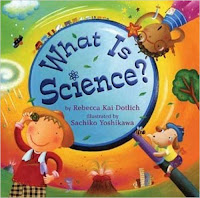I am always on the lookout for great books to use to teach everything - and science is no exception! When we are just introducing how to be a scientists, I like to choose books that are simple, but use strong vocabulary, have photos or illustrations that my students can relate to, and give students enough to think about so we can discuss and ask questions. (Come to think about it - those are the same criteria I use for pretty much every book I choose!) This post is the third in a series about introducing science to young students. You can read the other posts here:
These six books are my go-to books for science at the beginning of the year. Most are read alouds, but a couple of them can be done well with small groups. Unfortunately, not all of them are available. I'm going to share them anyway because teachers are masters at finding what we want, and you never know when a good book will show up at a tag sale or used book store.
What is a Scientist? by Barbara Lehn is a great beginning read-aloud for introducing scientific thinking. The pictures shows kids engaged in scientific activities such as observing and measuring and gives a brief explanation. This is a great jumping off point to introduce all the things a scientist does.
What is Science? by Rebecca Dotlich is a very simply written and colorful book that gives a variety of answers to the question, "What is science?" I like to ask my students this the very first time we start talking about science. We group our answers into scientific topics, science tools, scientific activities, etc. It's a great way to start a conversation and find out what your students know and think about science.
I Use Science Tools is part of an emergent reader series of science books. The text is very simple, but the photographs are a great way to make sure everyone is clear about what a variety of science tools are used for. I tend to show this one under the document camera, stopping to talk about how each tool is used.
Nature Spy, by Ken Kreisler is a great book to use when discussing the importance of observation. This book tells about how children can be a "nature spy" observing and noticing and recognizing patterns in nature. It's a very relatable book for students, which is why I keep it around.
Scientists Ask Questions, by Ginger Garrett is part of the Rookie Read-About Science series. Simple text and colorful photos make it engaging for young readers and there is just enough information for students to learn without being overwhelmed. I have 6-8 copies of this book and I like to use it in a small group. I put it out as a center after we have read it together.












No comments